Introduction
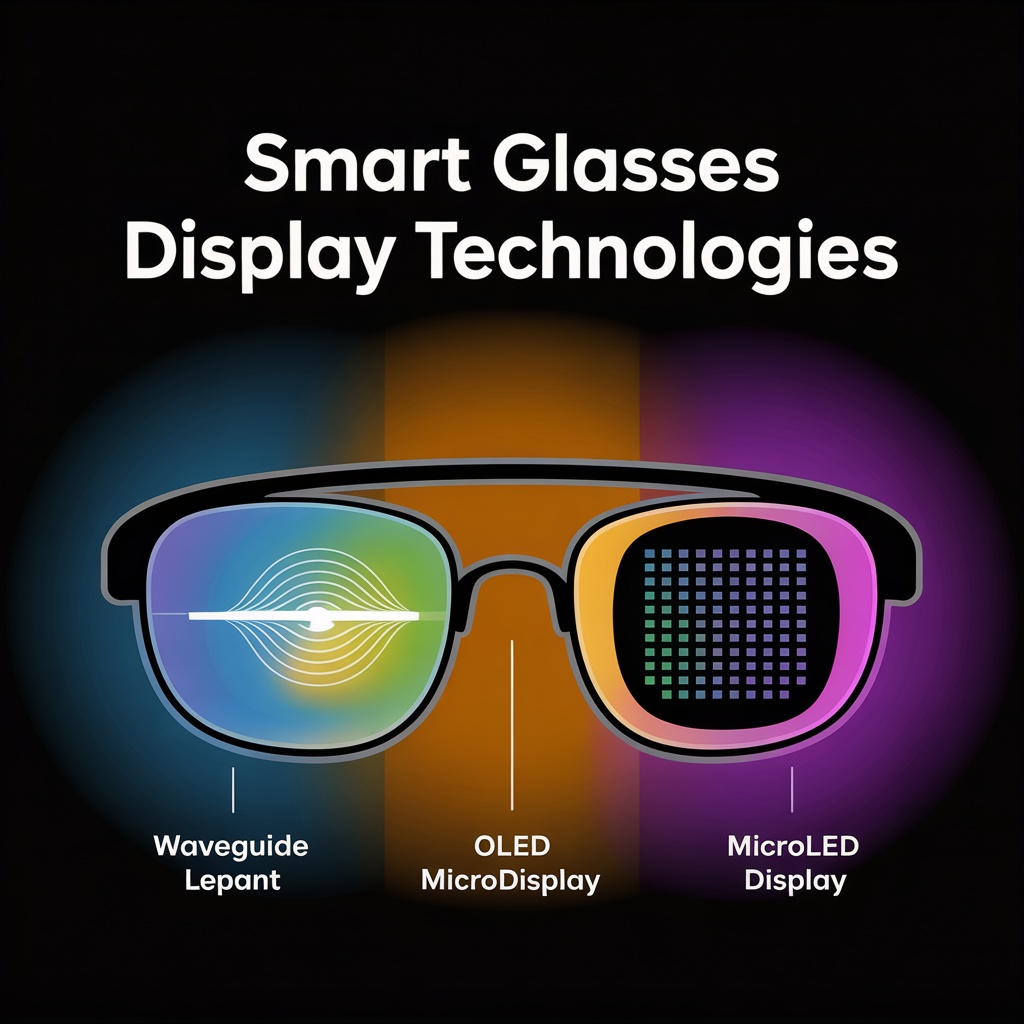
The smart glasses display is what transforms ordinary eyewear into a powerful computing platform. Modern AR smart glasses technology relies on sophisticated optical systems that balance high brightness for outdoor visibility, low power consumption for all-day battery life, compact size for comfortable wear, and transparent optics that don’t obstruct your vision.
This guide explores four smart glasses display technologies—waveguides, OLED, MicroLED, and HUD—covering how each works and their ideal applications.—
Understanding Smart Glasses Display Fundamentals
What Makes a Smart Glasses Display Different?
Smart glasses displays use transparent optics to overlay digital information on the real world, projecting readable images in bright conditions while maintaining see-through visibility.
Key Display Specifications
Key specifications:
Brightness: 1,000 nits (indoor) to 6,000+ nits (outdoor readability)
Resolution: 640×480 (basic HUD) to 1920×1080+ (immersive AR)
Field of View (FOV): 15-20° (notifications) to 50-70° (immersive AR)
Pixels Per Degree (PPD): Quality displays target 20+ PPD for comfortable reading, with premium models achieving 40+ PPD per RoadToVR research.—
Waveguide Display Technology
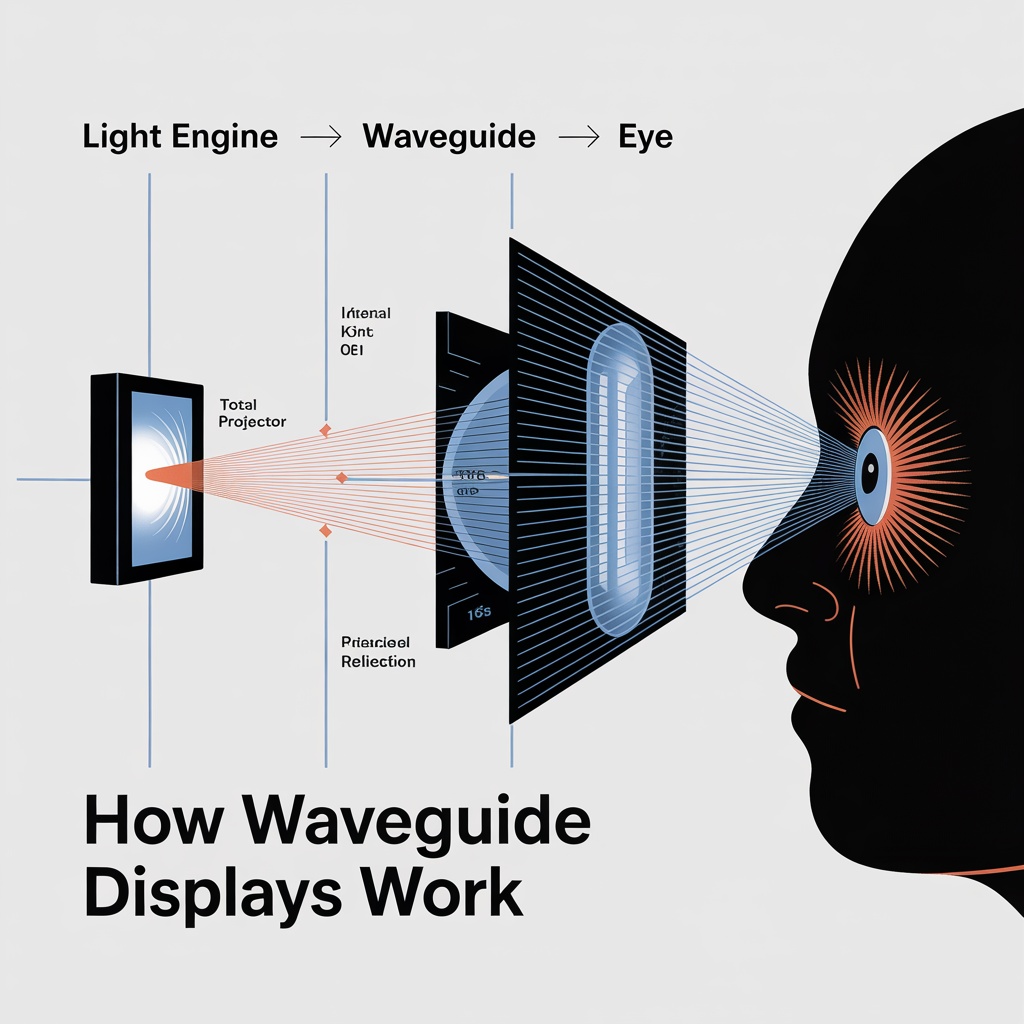
How Waveguide Displays Work
Waveguides create compact, see-through displays using two components:
Light Engine: A miniature projector using OLED or MicroLED that injects images into the waveguide.
Optical Waveguide: Transparent substrate using nanostructures or mirrors to guide light to your eye while maintaining see-through clarity.
According to display experts at Schott, waveguides operate on total internal reflection: “Light entering at specific angles becomes trapped within the substrate, bouncing along like a mirror corridor until extraction features direct it precisely toward your eye.”
Types of Waveguide Technology
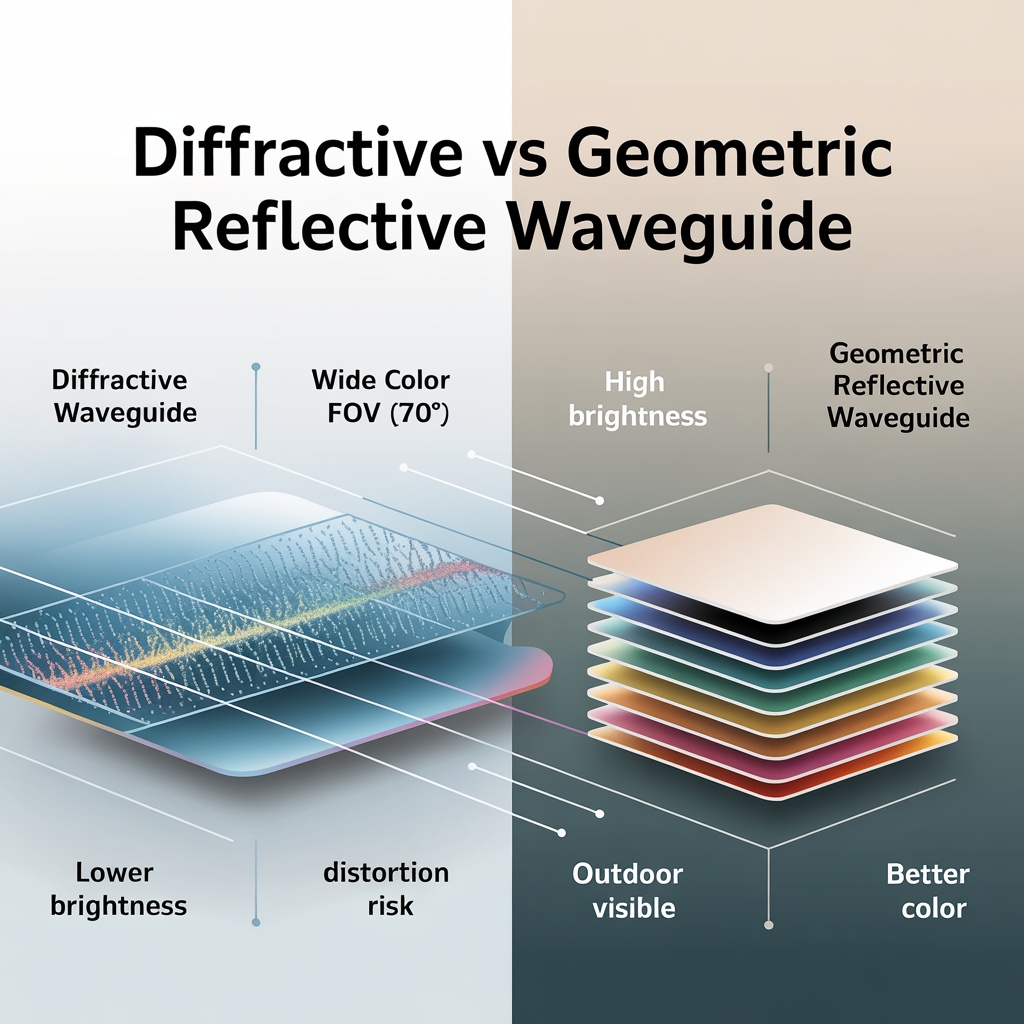
Diffractive Waveguides use nanostructures imprinted in the substrate to diffract light. These enable wide fields of view—Meta’s Orion prototype achieves 70° FOV. However, diffractive waveguides face challenges with color distortions and struggle with outdoor brightness.
Geometric Reflective Waveguides employ semi-transparent mirrors rather than nanostructures. These mirrors reflect light nearly losslessly, enabling significantly higher brightness and efficiency. The Meta Ray-Ban smart glasses use this technology, achieving outdoor-visible brightness while maintaining minimal external reflections for better eye contact.
According to Heise Technology, geometric reflective waveguides “achieve significantly higher image quality, brightness, and efficiency than diffractive waveguides, enabling displays that remain visible even outdoors in bright daylight.”
Waveguide Advantages and Limitations
Advantages:
– Truly transparent see-through optics – Compact form factor suitable for glasses-like designs – Wide fields of view (diffractive) or high brightness (geometric) – Lightweight designs under 60 grams
Limitations:
– High manufacturing complexity increases cost – Diffractive types struggle with outdoor visibility – Color uniformity challenges in some designs—
OLED Microdisplay Technology
How OLED Works in Smart Glasses
OLED (Organic Light-Emitting Diode) pixels emit their own light, enabling perfect blacks and high contrast. Micro-OLED panels (0.5-1 inch diagonal) deliver 2000+ PPI density with efficient power consumption.
OLED Display Advantages

Superior Contrast: OLED’s perfect blacks create images that appear to float convincingly in space, crucial for augmented reality where digital content must appear distinct from the real world.
Fast Response Time: OLED pixels switch in microseconds, eliminating motion blur—critical for AR experiences where latency causes disorientation.
Wide Color Gamut: Modern OLED displays produce vibrant, lifelike colors that make AR content more engaging.
Mature Manufacturing: OLED benefits from decades of development, translating to reliable production and reasonable costs for smart glasses technology manufacturers.
OLED Display Limitations
Limited Brightness: Most OLED displays max out around 2,000-3,000 nits—barely sufficient for outdoor use.
Burn-in Risk: Static UI elements can cause permanent image retention in OLED displays.
Shorter Lifespan: Organic materials degrade over time, particularly blue pixels.
Several Bluetooth smart glasses models use OLED displays for their balance of image quality and manufacturing maturity.—
MicroLED Display Technology

The Next-Generation Display Solution
MicroLED combines OLED’s contrast and speed with inorganic LED’s extreme brightness, no burn-in, and long lifespan. MiniMicroLED calls it “the ultimate solution for AR near-eye displays.”
How MicroLED Technology Works
MicroLED miniaturizes traditional LED structures to pixel sizes below 100 micrometers. Unlike OLED’s organic compounds, MicroLED uses inorganic gallium nitride (GaN) semiconductors—incredibly tiny versions of regular LEDs.
For smart glasses display manufacturing, LED wafers bond directly to CMOS driver chips at wafer scale, then MicroLED structures are fabricated using semiconductor photolithography. This achieves pixel densities exceeding 5,000 PPI.
MicroLED Advantages
Extreme Brightness: MicroLED displays achieve 10,000+ nits—more than sufficient for full-sunlight visibility. Leading manufacturer JBD has demonstrated displays reaching 10 million nits for green.
No Burn-in: Inorganic materials don’t degrade like OLED organics. The smart glasses display can show static interfaces indefinitely without image retention.
Superior Power Efficiency: At high brightness levels where OLED struggles, MicroLED maintains excellent efficiency, enabling all-day battery life.
Long Lifespan: MicroLED displays operate for 100,000+ hours—essentially outlasting the device itself.
Integration of MicroLED with smart glasses cameras creates powerful devices capable of both high-quality visual input and output.
MicroLED Challenges
Full-Color Complexity: Creating red, green, and blue MicroLEDs on a single substrate remains challenging. Current approaches include color-combining optics using separate RGB arrays, quantum dot color conversion, and direct RGB epitaxial growth.
Manufacturing Cost: MicroLED production requires specialized equipment, currently making it more expensive than OLED. However, costs decrease as production scales.
Leading companies like JBD and Leiyu Optoelectronics are now shipping MicroLED displays, with over 30 AR glasses models announced featuring MicroLED by late 2024.—
HUD (Heads-Up Display) Technology
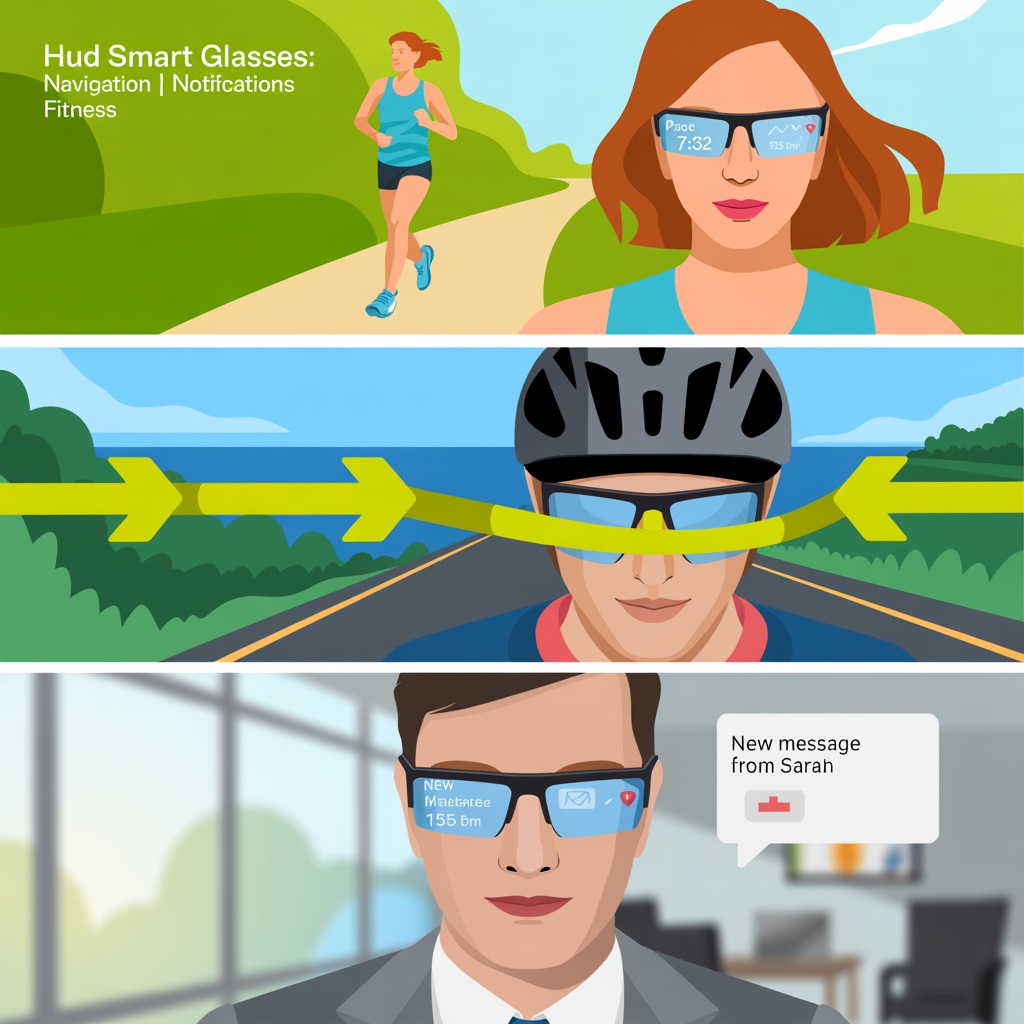
Understanding HUD Systems
HUD (Heads-Up Display) systems prioritize simplicity and all-day wear, showing a small notification window rather than filling your vision.
As explained by Even Realities, “AI glasses use a projection system to create a transparent image that appears to float in your field of view, achieved with micro-OLED projectors and waveguide technology.”
HUD Display Applications
HUD smart glasses display systems excel at specific use cases:
Notifications: See incoming calls and messages without pulling out your phone.
Navigation: Turn-by-turn directions appear in peripheral vision, valuable for cyclists and pedestrians.
Fitness Data: Runners view pace, distance, and heart rate without breaking stride.
Language Translation: Real-time translation subtitles appear as you listen.
HUD vs. Full AR Displays
HUD displays typically occupy 15-25° of visual field, showing simplified information in monochrome or limited color. They prioritize battery life (8+ hours) and lightweight construction (under 50 grams).
Full AR displays aim for 40-70° fields of view with full-color graphics and spatial positioning. They require more powerful processors, larger batteries, and bulkier optics. Studies from PLOS ONE show that larger AR fields of view improve interaction with virtual objects and result in more natural head orientations.—
Comparing Display Technologies

Brightness and Outdoor Visibility
Technology | Brightness | Outdoor Use ———–|———–|———— OLED | 1,000-3,000 nits | Moderate MicroLED | 5,000-10,000+ nits | Excellent Diffractive Waveguide | 1,000-3,000 nits | Moderate Geometric Waveguide | 3,000-6,000+ nits | Excellent HUD Systems | 1,500-4,000 nits | Good
Resolution and Field of View
OLED displays typically offer 1280×720 to 1920×1080 resolution with 40-50° FOV, balancing image quality and battery life.
MicroLED provides similar resolutions with superior brightness, enabling 30-50° FOV that continues expanding as technology matures.
Diffractive waveguides enable the widest FOV (40-70°) but depend on light engine specifications.
HUD systems use lower resolutions (320×240 to 640×480) with narrow 15-25° FOV, optimized for simple information display.

Power Consumption
HUD displays run 6-10 hours on small batteries. OLED-based AR glasses provide 2-4 hours continuous use. MicroLED AR glasses achieve 3-5 hours continuous or 8-12 hours intermittent, thanks to superior efficiency.—
Pre-Selection Checklist: Verify Your Display Requirements
Before choosing a smart glasses display, verify these essential requirements:
Environment Assessment
☐ Primary use location: Indoor-only, mixed indoor/outdoor, or outdoor-dominant
☐ Lighting conditions: Typical brightness levels (office, street, direct sunlight)
☐ Usage duration: Occasional glances (<1 hour), extended sessions (2-4 hours), or all-day wear (6+ hours)
Functional Requirements
☐ Information type: Simple notifications, navigation data, immersive AR content, or professional applications
☐ Field of view needs: Small HUD window (15-25°), standard AR (40-50°), or wide immersive AR (60°+)
☐ Battery priority: Maximum runtime vs. display performance
☐ Weight tolerance: Ultra-light (<50g), comfortable (50-70g), or acceptable bulk (70-100g)
Technical Preferences
☐ Brightness priority: Indoor-sufficient (1,000-2,000 nits) or outdoor-capable (5,000+ nits)
☐ Resolution needs: Basic text readability (PPD 15-20) or high-definition clarity (PPD 30-40+)
☐ Color requirements: Monochrome acceptable or full-color essential
Budget Constraints
☐ Price range: Budget-friendly (<$500), mid-range ($500-1,500), or premium ($1,500+)
☐ Priority trade-off: Affordable with compromises or best-in-class performance
Completing this checklist helps narrow technology choices to displays that match your actual needs rather than specs alone.—
Choosing the Right Display Technology
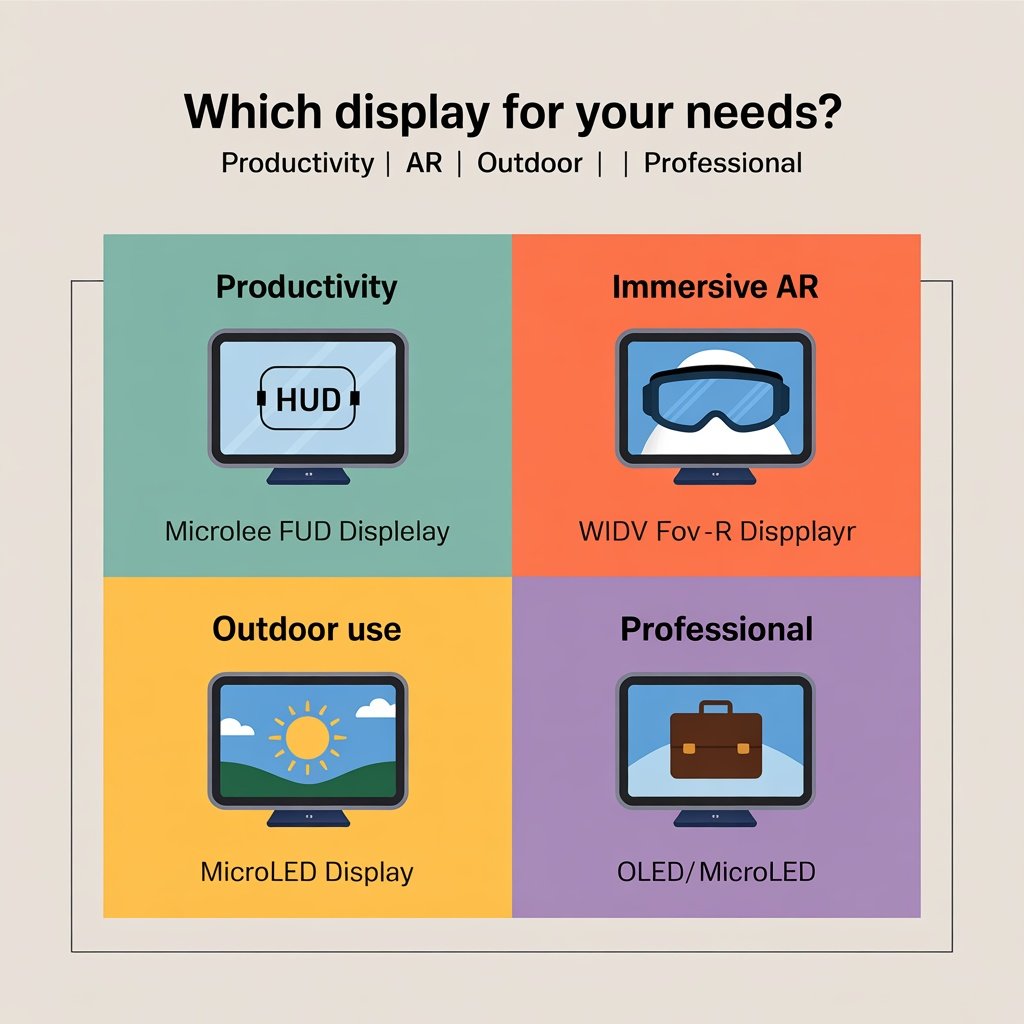
For Daily Productivity
If you want smart glasses that blend into daily life, prioritize long battery life (6+ hours), lightweight design (under 60g), outdoor visibility (3,000+ nits), and simple interfaces. HUD-style displays using geometric reflective waveguides offer the best balance.
For Immersive AR
For true augmented reality with virtual objects anchored in the real world, prioritize wide field of view (45°+), high resolution (1080p+), and spatial tracking. Full AR smart glasses with diffractive waveguides or high-performance MicroLED deliver these experiences.
For Outdoor Use
Runners, cyclists, and outdoor enthusiasts need maximum brightness (5,000+ nits), rugged design, and lightweight construction (under 50g). MicroLED displays excel here, remaining readable in direct sunlight.
For Professional Use
Business users value all-day reliability, clear text, and enterprise integration. Both OLED and MicroLED work well depending on indoor (OLED) or outdoor (MicroLED) use. Consider AI-powered smart glasses for professional workflows.
Budget Considerations
Smart glasses display technology significantly impacts pricing: – HUD displays with OLED: $300-600 – Basic AR with OLED: $500-1,000 – Advanced AR with MicroLED: $800-1,500+ – Cutting-edge AR: $2,000-5,000
Smart glasses pricing reflects display technology plus processor, cameras, battery, and software.—
Future Display Technology Developments
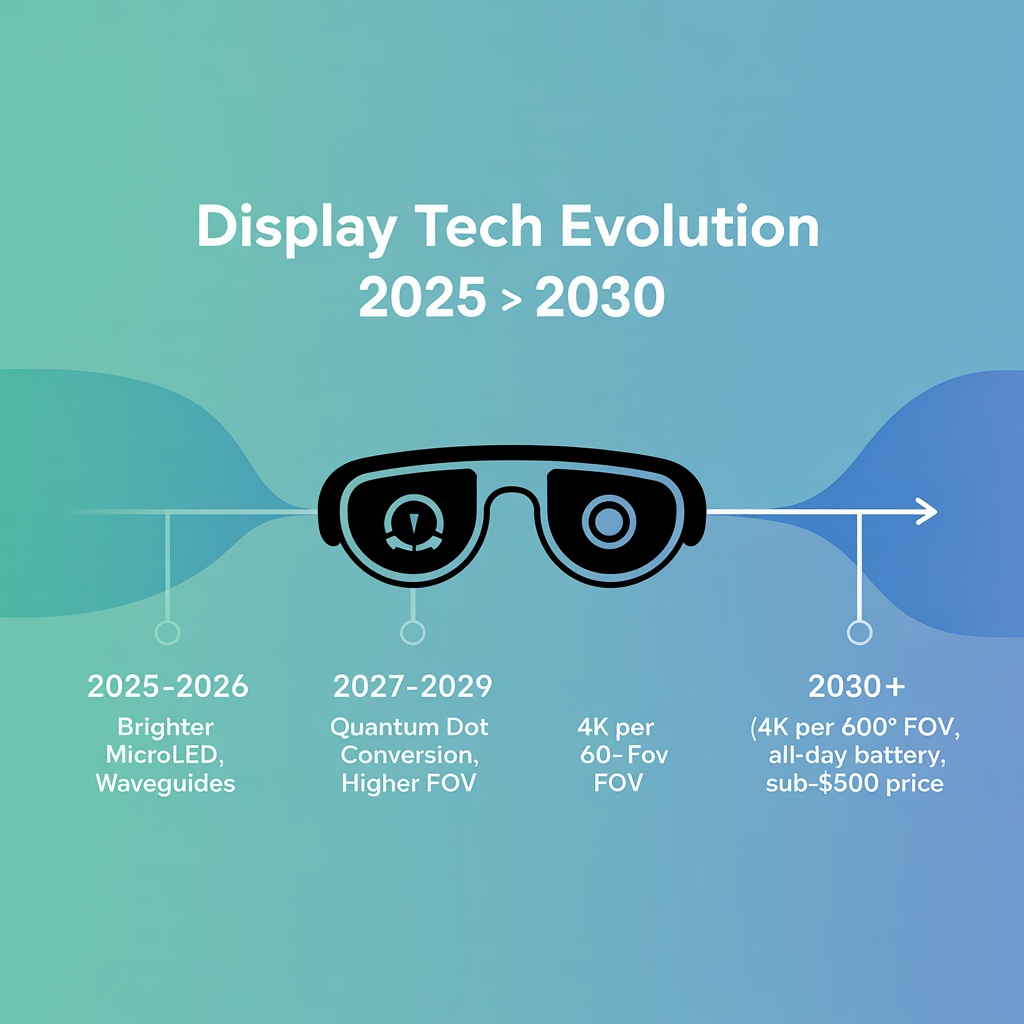
Near-Term (2025-2026)
MicroLED displays reaching 15-20 million nits will enable smaller optics. Improved waveguides will expand FOV while maintaining brightness. Monolithic full-color MicroLED will eliminate bulky color-combining optics.
Long-Term Vision (2030+)
The ultimate smart glasses display will combine MicroLED for extreme brightness, advanced waveguides providing 60-80° FOV, 4K resolution per eye, ultra-thin form factors under 5mm, all-day battery life (12+ hours), and sub-$500 consumer prices.
Explore the latest smart glasses and predictions about the future of smart glasses displays.—
Frequently Asked Questions
What is the best display technology for smart glasses?
There’s no single “best” technology. For maximum brightness and outdoor use, MicroLED excels. For color quality and mature manufacturing, OLED works well. For transparency and compact form factors, waveguide systems are ideal.
How bright do displays need to be?
For indoor smart glasses display use, 1,000-2,000 nits suffices. For occasional outdoor use, target 3,000-5,000 nits. For reliable outdoor visibility in direct sunlight, look for 5,000+ nits.
Do smart glasses displays cause eye strain?
Properly designed smart glasses displays shouldn’t cause more strain than other screens. Viewing a display several feet in apparent distance may be less straining than looking at a phone held close. Key factors include adequate brightness, sufficient resolution, and proper optical alignment.
Can you see displays in bright sunlight?
Smart glasses display brightness varies dramatically. OLED-based displays typically struggle in direct sunlight (<3,000 nits). MicroLED displays excel outdoors (5,000-10,000+ nits). If outdoor use is critical, prioritize specifications listing 5,000+ nits brightness and MicroLED technology.
What is 4K smart glasses quality?
“4K smart glasses display” refers to 3840×2160 resolution per eye, though true 4K in compact glasses remains rare. Most consumer smart glasses display devices offer 720p to 1080p per eye. The more important specification is Pixels Per Degree (PPD)—quality smart glasses achieve 20+ PPD, making pixels imperceptible.
How do waveguide displays work?
Waveguide displays use transparent optical substrates that guide light from a small projector to your eye while maintaining transparency. Light enters at specific angles, bounces along through total internal reflection, then exits precisely toward your eye using extraction features (nanostructures or mirrors).—
Common Display Issues and Solutions
Issue 1: Display Unreadable Outdoors
Symptom: Smart glasses display appears dim or invisible in bright sunlight.
Root Cause: Display brightness insufficient to overcome ambient light. OLED displays maxing at 2,000-3,000 nits struggle against 100,000+ nits sunlight.
Solutions:
1. Immediate: Adjust viewing angle—tilt glasses slightly to reduce direct sunlight reflection on the display surface 2. Software: Enable maximum brightness mode (reduces battery life but improves visibility) 3. Long-term: If outdoor use is essential, upgrade to MicroLED-based smart glasses with 5,000+ nits brightness
Issue 2: Rainbow Effect or Color Fringing
Symptom: Visible rainbow-like color separation around white text or high-contrast edges.
Root Cause: Diffractive waveguide chromatic dispersion—different wavelengths diffract at slightly different angles.
Solutions:
1. Adjust position: Center glasses precisely on your face—misalignment exaggerates dispersion 2. Software settings: Some devices offer color correction profiles to minimize visible artifacts 3. Consider alternatives: If rainbow effects are intolerable, geometric reflective waveguide designs eliminate this issue entirely
Issue 3: Battery Drains Too Quickly
Symptom: Smart glasses display battery depletes within 1-2 hours despite manufacturer’s 4+ hour rating.
Root Cause: High brightness settings and OLED’s power consumption increase exponentially with brightness.
Solutions:
1. Optimize brightness: Reduce display brightness to minimum comfortable level—brightness at 80% uses ~60% more power than 50% 2. Content optimization: Use dark UI themes (OLED pixels off = zero power consumption for black areas) 3. Usage patterns: Enable auto-sleep—display should deactivate after 10-30 seconds of inactivity 4. Hardware consideration: MicroLED displays maintain better efficiency at high brightness; consider upgrading if outdoor visibility requires constant high brightness—
Conclusion
Smart glasses display technology has reached an inflection point where multiple mature approaches offer compelling benefits. Whether you prioritize outdoor brightness (MicroLED), wide field of view (diffractive waveguides), all-day battery life (HUD systems), or balanced features (OLED with geometric waveguides), today’s market offers genuine choices.
Understanding these smart glasses display technologies empowers informed evaluation. The best choice aligns with your needs—productivity, AR immersion, outdoor fitness, or connectivity.
As display technology continues evolving, smart glasses will become increasingly capable, comfortable, and affordable. Innovations in MicroLED efficiency, waveguide design, and manufacturing processes are paving the way for augmented reality glasses that blend seamlessly into daily life while delivering useful information exactly when you need it.
About the Author
David Chen is an AR technology specialist with over 8 years of experience in wearable computing and display systems. He has tested and reviewed more than 50 smart glasses models and regularly consults with leading AR hardware manufacturers on optical design optimization.